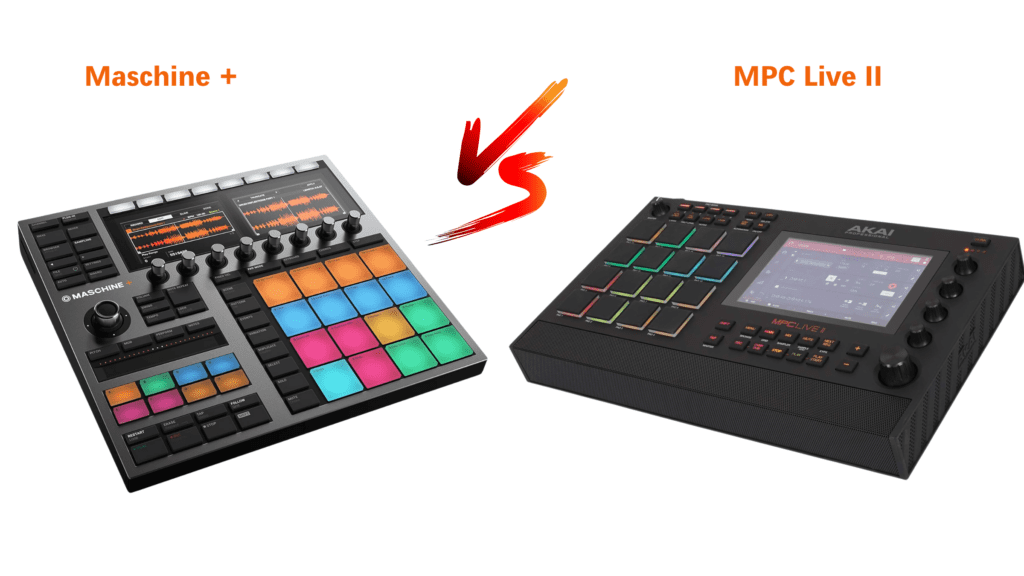Ultimate Showdown: Native Instruments Maschine+ vs. Akai MPC Live II

Native Instruments Maschine+ vs. Akai MPC Live II
When evaluating grooveboxes for modern music production, the Native Instruments Maschine+ and the Akai MPC Live II stand out as two of the most capable and feature-rich options. This comparison review will delve into key specs and features, including pros and cons, to help you understand their strengths and how they stack up against each other.
Maschine+
Build Quality and Design
Featuring a sleek, matte-black finish with robust, high-quality pads and rotary encoders, Maschine+ is designed to be both aesthetically pleasing and durable. The two high-resolution color displays provide clear visual feedback and ease of navigation.
Standalone Capabilities
As a standalone device, Maschine+ allows complete music production without needing a computer. It runs on its own embedded system, providing access to Native Instruments’ powerful software and extensive sound library.
User Interface
Offers an intuitive interface with two high-resolution screens, making it easy to browse sounds, tweak parameters, and arrange tracks. The combination of physical controls and touch-sensitive knobs enhances the user experience.
Sampling and Sequencing
Known for its powerful sampling capabilities, Maschine+ allows users to sample directly into the device, chop, and manipulate samples with ease. Its sequencer is highly regarded for creating intricate patterns and arrangements.
Performance Features
Designed with live performance in mind, it includes features like real-time effects, scene and pattern switching, and integration with Native Instruments’ extensive effects and instruments library.
Storage and Connectivity
Comes with 32GB of internal storage and supports SD cards and external drives for expansion. Connectivity options include MIDI In/Out, USB, and audio inputs/outputs, catering to a range of studio setups.
Software Integration
Integrates seamlessly with Native Instruments’ Komplete ecosystem, offering access to a vast library of sounds and instruments. The workflow is smooth, with tight integration between hardware and software.
Pros:
- Excellent software integration with Native Instruments’ ecosystem.
- Powerful sampling and sequencing capabilities.
- Intuitive interface with dual high-resolution screens.
- Robust build quality.
- Extensive internal storage with expandability.
Cons:
- Slightly larger footprint, can feel bulky.
- Interface can be overwhelming for beginners.
- Dependent on firmware updates for optimal performance.
MPC Live II
Build Quality and Design
The MPC Live II boasts a rugged build with a modern touchscreen interface, responsive pads, and added features like built-in speakers for convenience. The design includes numerous physical controls, ensuring a tactile experience.
Standalone Capabilities
Similarly, the MPC Live II functions as a standalone unit, featuring a built-in battery and a comprehensive software suite. It supports standalone operation with the same workflow and capabilities as when connected to a computer.
User Interface
Features a large, responsive touchscreen that simplifies navigation and editing tasks. The layout is user-friendly, with dedicated buttons for common functions and a familiar MPC workflow that integrates well with the touchscreen.
Sampling and Sequencing
Excels in sampling, offering real-time time-stretching, pitch-shifting, and advanced sample editing. The step sequencer and grid editor make it easy to create complex beats and sequences, catering to a variety of production styles.
Performance Features
Equally performance-oriented, the MPC Live II offers live recording, clip launching, and an array of real-time effects. The addition of built-in speakers enhances its portability for on-the-go performances.
Storage and Connectivity
Provides 16GB of internal storage with expansion options via SD card and SATA drive bays. It features comprehensive connectivity, including MIDI, USB, CV/Gate outputs, and balanced audio inputs/outputs, making it versatile for various production environments.
Software Integration
Works well with Akai’s MPC Software, providing a standalone DAW experience. It can also integrate with popular DAWs like Ableton Live, offering flexibility in how users can incorporate it into their setups.
Pros:
- Comprehensive standalone functionality with a built-in battery.
- User-friendly touchscreen interface.
- Advanced sampling features, including real-time manipulation.
- Extensive connectivity options, including MIDI, USB, and CV/Gate.
- Built-in speakers enhance portability.
Cons:
- Slightly heavier due to built-in speakers.
- Initial internal storage is less than Maschine+.
- Learning curve for Akai’s MPC Software.
Conclusion
Both the Native Instruments Maschine+ and the Akai MPC Live II are top-tier grooveboxes, each with unique strengths:
Maschine+ excels in software integration and offers a highly intuitive interface, making it ideal for users already invested in the Native Instruments ecosystem. It provides a seamless experience for studio production and live performance with its powerful sampling and sequencing capabilities.
MPC Live II stands out for its comprehensive standalone capabilities, user-friendly touchscreen interface, and robust connectivity options, making it suitable for a wide range of production and performance scenarios. Its portability and built-in speakers enhance its versatility for on-the-go use.
Your choice between the two will largely depend on your specific workflow preferences, existing equipment, and production needs. Both devices are excellent investments for any serious music producer looking to enhance their setup with a powerful and versatile groovebox.
Share this post!
